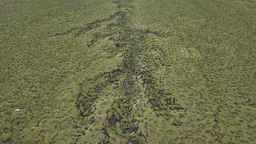
In 2015, world leaders gathered in Paris and agreed to the long-term goal of limiting global warming to 1.5ºC. This requires a fundamental transformation of the global economy. Not only do we need to drastically reduce CO2 emissions, but we also need to run climate change in reverse with negative emissions technologies (NETs) to actively remove CO2 from the atmosphere. The vast majority of modeling scenarios underpinning reports by the Intergovernmental Panel on Climate Change lean heavily on the future ability to achieve negative emissions at a comparable scale to our current (positive) emissions. In our new paper published today in Nature Climate Change, we quantify how negative emission technologies can affect global food supply, water use, and energy demand. We particularly focus on direct air capture technology, an engineered process for separating and storing CO2 from the atmosphere. We find that DAC could begin removing up to 3 GtCO2 per year by 2035; over 50% of U.S. CO2 emissions in 2017.
Such rapid scale up of DAC would require ambitious policies for compensating CO2 removal but would substantially reduce the total cost of addressing climate change. DAC’s strongest competitors are land-based negative emission technologies, which include global net additions to forested land (requiring a halting and reversal of today’s deforestation), as well as bioenergy combined with carbon capture and storage. As we have highlighted in previous work, these land-intensive NETs which we are currently “betting the farm on”, come with their own set of side effects: namely, large-scale displacement of productive agricultural and natural lands, as well as placing additional strain on global water resources due to irrigation requirements. Bioenergy also requires large inputs of fertilizer with its associated costs and pollution problems. Our work published today for the first time quantifies and clearly communicates the extent of the tradeoffs resulting from each of the three negative emissions technologies assessed. DAC can soften - but not eliminate – the sharpest tradeoffs resulting from land competition between farmland and land needed for new forests and bioenergy.
For all its potential, though, DAC is no silver bullet for addressing climate change. Although DAC is far less water-intensive per unit of CO2 removal than bioenergy and forests, its global-scale deployment could increase water withdrawals and consumption globally owing to its large potential to displace CO2 emissions abatement. DAC would also require a large dedicated energy supply comparable to current-day global natural gas demand, raising concerns about fugitive methane emissions offsetting some of the climate benefits of CO2 removal. And, even with low-cost DAC available, staple food crop prices still increase approximately 3-fold globally relative to 2010 levels and 5-fold in many parts of the Global South, due to remaining competition for agricultural land from bioenergy cultivation and afforestation activities. This inequitable distribution of burdens of disposing of atmospheric CO2 will unfortunately mirror the inequities climate change itself, which we are now increasingly relying on future negative emissions to remediate.
We found that much of the need for negative emissions, and their associated tradeoffs is driven by offsets for expensive-to-mitigate sectors. Our future work will therefore focus on novel methods to avoid emissions in the first place, rather than relying as we do now on presumed large-scale forestry, agricultural, and industrial activities to dispose of already-emitted CO2. If the world is serious about meeting the 1.5 degree goal or anything close to it, we will need to act immediately to (1) deploy conventional abatement technologies such as solar and wind, and (2) invest in R&D to develop cost effective negative emissions technologies. These two sets of technologies must work together to meet any reasonable limits on warming, but they will only be deployed at the scales required if we put policies in place now that are commensurate with the magnitude of the climate crisis. Each year that we delay ambitious climate action further commits us to future large-scale and expensive CO2 removal to avoid catastrophic warming.
Follow the Topic
-
Nature Climate Change

A monthly journal dedicated to publishing the most significant and cutting-edge research on the nature, underlying causes or impacts of global climate change and its implications for the economy, policy and the world at large.



Please sign in or register for FREE
If you are a registered user on Research Communities by Springer Nature, please sign in